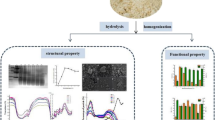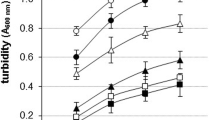Abstract
The sensitivity of soy protein isolate (SPI) to trypsin was characterized by its flexibility. The effects of different homogenization conditions on soy protein isolate flexibility and emulsifying properties were investigated. Set the homogenization pressure was 120 MPa (megapascal) and the homogenous number of times is 0–4 times, the flexibility increases with the increase of the homogenization times (0–3 times), the change trend of flexibility is not obvious (3–4 times). When the homogenization times was 0–3 times, the emulsifying activity increases, and the emulsifying activity was the strongest at 3 times, after homogenization 3 times, the change trend of emulsifying activity is not obvious, the trend of emulsification stability and emulsification activity were similar. The surface hydrophobicity increases with the increase of homogenization times, while the turbidity decreases. The other structural indicators such as Ultraviolet scanning and endogenous tryptophan fluorescence spectroscopy suggest that the structure of SPI becomes more stretch as the flexibility increases.






Similar content being viewed by others
References
Friedman M, Brandon D L. Nutritional and health benefits of soy proteins[J]. Journal of Agricultural & Food Chemistry, 2001, 49(3):1069–1086.
Ma L, Li B, Han F, Yan S, Wang L, Sun J. Evaluation of the chemical quality traits of soybean seeds, as related to sensory attributes of soymilk.[J]. Food Chemistry, 2015, 173:694–701.
Nishinari K, Fang Y, Guo S, Phillips G O. Soy proteins: A review on composition, aggregation and emulsification[J]. Food Hydrocolloids, 2014, 39(2):301–318.
Kato A, Nakai S. Hydrophobicity determined by a fluorescence probe method and its correlation with surface properties of proteins[J]. Biochim Biophys Acta. 1980, 624(1):13–20.
Damodaran S. Protein Stabilization of Emulsions and Foams[J]. Journal of Food Science, 2010, 70(3):R54–R66.
Shimizu M, Takahashi T, Kaminogawa S, Yamauchi K. Adsorption onto an oil surface and emulsifying properties of bovine. alpha.s1-casein in relation to its molecular structure[J]. J.agric.food Chem, 1983, 31(6):1214–1218.
Townsend A A, Nakai S. Relationships between hydrophobicity and foaming characteristics of food proteins.[J]. Journal of Food Science, 2010, 48(2):588–594.
Kato A, Komatsu K, Fujimoto K, Kobayashi K. Relationship between surface functional properties and flexibility of proteins detected by the protease susceptibility[J]. Journal of Agricultural & Food Chemistry, 1985, 33(33):931–934.
Tang C H, Shen L. Role of Conformational Flexibility in the Emulsifying Properties of Bovine Serum Albumin[J]. Journal of Agricultural & Food Chemistry, 2013, 61(12):3097–3110.
Cui, Z., Chen, Y., Kong, X., Zhang, C., and Hua, Y. (2014). Emulsifying properties and oil/water (O/W) interface adsorption behavior of heated soy proteins: Effects of heating concentration, homogenizer rotating speed, and salt addition level. Journal of Agricultural and Food Chemistry, 62:1634–1642.
Li, F., Kong, X., Zhang, C., and Hua, Y. (2011). Effect of heat treatment on the properties of soy protein-stabilised emulsions. International Journal of Food Science and Technology, 46:1554–1560.
Liang, H. N., and Tang, C. H. (2013). Emulsifying and interfacial properties of vicilins: Role of conformational flexibility at quaternary and/or tertiary levels. Journal of Agricultural and Food Chemistry, 61:11140–11150.
Liang, H. N., and Tang, C. H. (2014). Pea protein exhibits a novel Pickering stabilization for oil-in-water emulsions at pH 3.0. LWT-Food Science and Technology, 58:463–469.
Tang C H, Shen L. Dynamic adsorption and dilatational properties of BSA at oil/water interface: Role of conformational flexibility[J]. Food Hydrocolloids, 2015, 43:388–399.
Floury J, Desrumaux A, Lardières J. Effect of high-pressure homogenization on droplet size distributions and rheological properties of model oil-in-water emulsions[J]. Innovative Food Science & Emerging Technologies, 2000, 1(2):127–134.
Weiss J, Takhistov P, Mcclements J. Functional Materials in Food Nanotechnology[J]. Journal of Food Science, 2006, 71(9):R107–R116.
Puppo M C, Speroni F, Chapleau N, De Lamballerie M, Anon M C, Anton M. Effect of high-pressure treatment on emulsifying properties of soybean proteins.[J]. Food Hydrocolloids, 2005, 19(2):289–296.
Bouaouina H, Desrumaux A, Loisel C, Legrand J. Functional properties of whey proteins as affected by dynamic high-pressure treatment[J]. International Dairy Journal, 2006, 16(4):275–284.
Sorgentini D A, Wagner J R. Comparative study of structural characteristics and thermal behavior of whey and isolate soybean proteins.[J]. Journal of Food Biochemistry, 2010, 23(5):489–507.
Hayakawa S, Nakai S. Relationships of hydrophobicity and net Charge to the solubility of milk and soy proteins[J]. Journal of Food Science, 1985, 50(2):486–491.
Liang H N, Tang C H. Emulsifying and Interfacial Properties of Vicilins: Role of Conformational Flexibility at Quaternary and/or Tertiary Levels[J]. Journal of Agricultural & Food Chemistry, 2013, 61(46):11140–11150.
Liu Y, Zhao G, Zhao M, Ren J, Yang B. Improvement of functional properties of peanut protein isolate by conjugation with dextran through Maillard reaction[J]. Food Chemistry, 2012, 131(3):901–906.
Tang S, Hettiarachchy N S, Horax R, Eswaranandam S. Physicochemical Properties and Functionality of Rice Bran Protein Hydrolyzate Prepared from Heat-stabilized Defatted Rice Bran with the Aid of Enzymes[J]. Journal of Food Science, 2006, 68(1):152–157.
Puppo C, Chapleau N, Speroni F, de Lamballerie-Anton M, Michel F, Añón C, Anton M. Physicochemical modifications of high-pressure-treated soybean protein isolates.[J]. Journal of Agricultural & Food Chemistry, 2004, 52(6):1564.
Tedford L A, Smith D, Schaschke C J. High-pressure processing effects on the molecular structure of ovalbumin, lysozyme, and â-lactoglobulin. Food Research International, 1999, 32, 101–106.
Hayakawa I, Linko Y-Y, Linko P. Mechanism of highpressure denaturation of proteins. Lebensmittel-Wissenschaft und-Technologie-Food Science and Technology, 1996, 29, 756–762.
Tedford L A, Smith D, Schaschke C J. High pressure processing effects on the molecular structure of ovalbumin, lysozyme, and β-lactoglobulin. Food Research International, 1999, 32, 101–106.
Cromwell M E M, Hilario E, Jacobson F. Protein aggregation and bioprocessing[J]. The Journal of American Association of Pharmaceutical Scientists, 2006, 8(3):E572–E579.
İbanoǧlu E, Karataş Ş. High pressure effect on foaming behaviour of whey protein isolate[J]. Journal of Food Engineering, 2001, 47(1):31–36.
Fernándezávila C, Escriu R, Trujillo A J. Ultra-High Pressure Homogenization enhances physicochemical properties of soy protein isolate-stabilized emulsions.[J]. Food Research International, 2015, 75:357–366.
Hebishy E, Buffa M, Juan B, Blasco-Moreno, A, Trujillo, A J. Ultra high-pressure homogenized emulsions stabilized by sodium caseinate: Effects of protein concentration and pressure on emulsions structure and stability[J]. LWT - Food Science and Technology, 2017, 76:57–66.
Wang W, Zhu Y, Chen T, Zhou G. Kinetic and thermodynamic analysis of ultra-high pressure and heat-induced denaturation of bovine serum albumin by surface plasmon resonance[J]. Tropical Journal of Pharmaceutical Research, 2017, 16(8):1965.
Ruso J M, González-Pérez A, Prieto G, Sarmiento F. Study of the interactions between lysozyme and a fully-fluorinated surfactant in aqueous solution at different surfactant-protein ratios[J]. International Journal of Biological Macromolecules, 2003, 33(1):67–73.
Wang X S, Tang C H, Li B S, Yang X Q, Li L, Ma C Y. Effects of high-pressure treatment on some physicochemical and functional properties of soy protein isolates[J]. Food Hydrocolloids, 2008, 22(4): 560–567.
Subirade M, Loupil F, Allain A F, Paquin P. Effect of dynamic high pressure on the secondary structure of beta-lactoglobulin and on its conformational properties as determined by Fourier transform infrared spectroscopy.[J]. International Dairy Journal, 1998, 8(2): 738–744.
Kato A, Fujimoto K, Matsudomi N, Kobayashi K. Protein flexibility and functional properties of heat-denatured ovalbumin and lysozyme.[J]. Bioscience Biotechnology & Biochemistry, 1986, 50(2):417–420.
Acknowledgements
The work was supported by funds from the National Soybean Industry Technical System Project (CARS-04-PS25).
Author information
Authors and Affiliations
Corresponding author
Rights and permissions
About this article
Cite this article
Xu, Y., Wang, G., Wang, X. et al. Effects of homogenization on the molecular flexibility and emulsifying properties of soy protein isolate. Food Sci Biotechnol 27, 1293–1299 (2018). https://doi.org/10.1007/s10068-018-0361-x
Received:
Revised:
Accepted:
Published:
Issue Date:
DOI: https://doi.org/10.1007/s10068-018-0361-x




